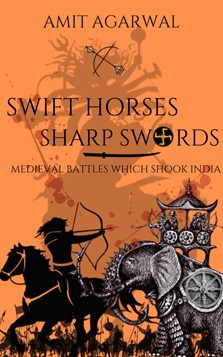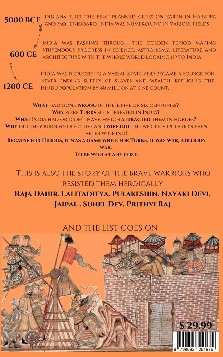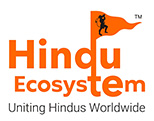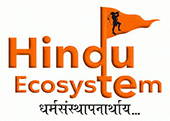

I recently came across the book on Indian medieval history titled “Swift Horses Sharp swords: Medieval battles which shook India” written by an IIT graduate Amit Agarwal. It’s very rare for a technocrat to write a history book as it requires deep knowledge, intense passion and sustained efforts. Here is my attempt to review the book for the benefit of fellow readers. The most important facet of the book is that it is written from a Hindu perspective.
One of the most unfortunate parts of history is that “it is written by the victors” and the truth of the past is not often chronicled by well-researched historical scholarship or a factual understanding of the past, but by the might of political and cultural leaders on the “winning” side. Indian medieval history, as recorded by most conventional history books, suffers most from such bias as it has been written under the victory halo of Arabs, Turks and Mughals. This book is a refreshing change from the past as it covers medieval battles in great detail without the “winning bias” and giving due importance to all authentic historical accounts irrespective of their leanings.
The book mainly deals with battles fought by Indian rulers against Turkic invaders before 1200 CE and the consequences of those battles. The book can be divided into 3 parts, the first part has chapters that talk about important events, times of Indian society starting from Indus civilisation till the creation of Islam.
The second part is the main or important part of the book, it deals with the expansion of Islam, Indian rulers who fought against invaders.
The first part of the book provides a glimpse of the rich social, economic and cultural life prevailed in India during the ancient period and covers topics such as silk route trading, booming business and art during the Gupta period, Hinduism and their caste system, the emergence of Buddhism and its spread in the region. This part builds a sort of social, cultural and historical background leading to a more tumultuous medieval period. The book also highlights the weakness of Indian society and its rulers which remained hugely divided and unprepared which eventually led to its decline and prolonged subjugation.
It is the second part in which the author truly comes into his element and wrote with full passion. This part covers the early medieval period from the 7th century till the 13th century in great detail and analyses the conditions encompassing social, economic, religious, technological and geographical factors of that era and their interplay. The book is a detailed account of various critical battles of medieval times covering all aspects and their aftermath. Invading armies not only had well conceptualised war strategies and battle formations but also deployed superior weaponry such as sturdy Chainmail armour, solid tree saddle and the metallic stirrup which were designed and developed in Central Asia. The book covers finer nuances of actual battles and is full of small anecdotes which most readers will find interesting such as the ability of the Turks to accurately fire 6 arrows per minute while galloping on the horse or their travelling speed of 100 Kms per day which meant they could come in a flat 10 days from Ghazni in Afghanistan.
The author also describes all the attacks of Islamic invaders in detail and gave ample details of all the attacks of Mahmud of Ghazni and how heroically several Indian rulers fought him but couldn’t finish him for good. The comparison of military strategies of invaders and Indian rulers gives a glimpse into why several Indian rulers who put up a fight had lost. The author shows how Sufi or local Muslim preachers asked Turkic rulers to attack India and help in spreading Islam, in creating saints out of invaders, Masud, nephew of Mahmud was made a saint after his defeat at the hands of King Suheldev and that even Hindus now visit his annual death anniversary festival. The account of battles fought by Jaipal, Anandpal, Prithviraj Chauhan, Suheldev etc. and many other names which we never heard in school history books are discussed in detail.
It is often portrayed as if the invasion was a cakewalk for the invaders but the book tides over this winning bias of oversimplification of history. It chronicled many critical battles of mediaeval times in great detail where the defending Indian kings displayed intense bravery, fought valiantly and left their imprints on the historical canvass.
The book has explained beautifully how polytheism has always been an epitome of tolerance in contrast to monotheism and how it came to dominate other polytheistic beliefs is also elaborately explained. Another chapter “In praise of Idolatry” is also unique and deals with images of deities and why all Abrahamic religions abhor them. The book also transacts with follies of Hindu religion especially about casteism which has been such a menace in Indian society which prevented people from unifying under one national umbrella.
The last chapters of this book also discuss the consequences of these invasions and analyses of battles and provide the data of the number of people killed and made into a slave, the amount of wealth looted and temples destroyed by the invaders. The data culled from the various sources is mind-boggling and analysed properly. The author has integrated various mathematical models like game theory to explain the survival of Hindu society.
The book has also brought out the follies committed by the Indian warriors in that period. Despite being super-rich, somehow technological innovation could not keep pace with that of Turks. The overemphasis of Dharamyuddha was another huge factor in the recurring defeats. Just to quote an example: Ghori was lying on the battlefield unconscious with injuries and Rajputs had all the time to kill him. Yet they did not find it morally right to kill an injured and unarmed warrior. Consequently, his soldiers managed to take him back to Ghazni. He then practised with the dummy mud elephants as the Indian elephants were his chief nemesis in the battle. Within a year, Ghori came back to attack India with renewed preparation and refined strategy. Some other reasons which worked against Indian warriors were the inability to seize timely initiatives, lack of strategic and tactical war planning, poor choice of war terrain and battlegrounds, lack of surprise element in battles and weak espionage system.
The book has certain weaknesses too. The book is too long with more than 500 pages and it should have been split into 2 volumes. There are few typos and grammatical errors too which should be corrected in the next edition. Initial chapters of the Silk route etc. should be trimmed down.
The content of the book is very rich and the author has used many renowned history books as references. The author has not shied away from expressing his understanding of history in an uninhibited way even on some controversial topics. Overall it’s a very interesting book written in simple English and most readers will find it very engaging. The book is good for those who never read anything regarding Islamic invasions other than school history books, as this book provides the key details of those invasions which gives an actual picture of what happened.
The book is available on Amazon (https://www.amazon.com/Swift-Horses-Sharp-Swords-Medieval/dp/B08KH3R4MN) and has got excellent ratings of 4.5 with 162 reviews.
#bookreview #indianbook #medieval #historyofindia #indianculture #indianhistory #trueindia #indiahistoryeducation #indianmedievalhistory #SwiftHorsesSharpSwords #Medievalbattles #Medievalindia


